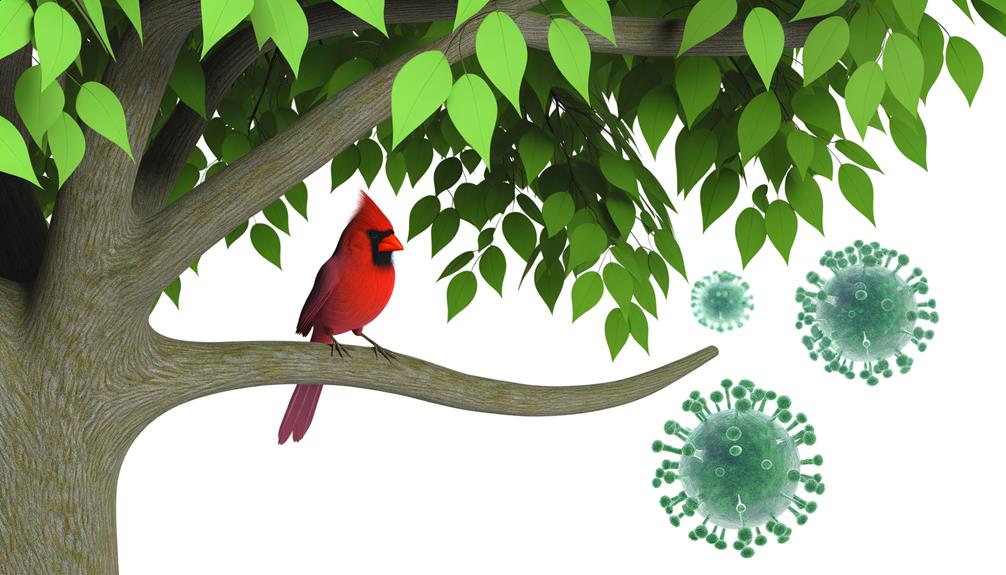How Cardinals Get Bird Flu and Ways to Protect Them
Cardinals, being passerine birds, are susceptible to avian influenza. Susceptibility is influenced by genetic makeup, immune response, and environmental exposure.
Direct contact with infected birds or contaminated environments can transmit the virus. Shared feeding sites and proximity to waterfowl populations also increase risk.
Symptoms in infected cardinals include respiratory distress and lethargy. Preventative strategies are focused on habitat management and vaccination development.
Ongoing research aims to understand their role in disease transmission and implement measures to mitigate risks. Learn about the intricacies that govern how avian influenza affects cardinals and broader avian communities.

Key Takeaways
- Cardinals are susceptible to avian influenza due to genetic and environmental factors.
- Direct contact with infected birds can transmit the virus to cardinals.
- Cardinals' communal feeding behavior heightens their risk of contracting bird flu.
- Proximity to waterfowl habitats increases cardinals' exposure to avian influenza.
- Further research is needed to understand cardinals' role as potential vectors of bird flu.
What Is Bird Flu?
Bird flu, also known as avian influenza, is an infectious viral disease that primarily affects bird species and is caused by influenza type A viruses. These viruses are categorized based on two surface proteins, hemagglutinin (H) and neuraminidase (N), resulting in subtypes such as H5N1 and H7N9, which have attracted significant attention.
Avian influenza viruses are highly adaptable, allowing them to infect various avian hosts, leading to a spectrum of disease presentations from asymptomatic to severe respiratory distress and high mortality rates. Transmission occurs via direct contact with infected birds, contaminated surfaces, or through aerosols.
Importantly, certain strains possess zoonotic potential, raising public health concerns regarding cross-species transmission and necessitating vigilant monitoring and control measures.
Cardinal Habitats and Behaviors
Cardinals mainly inhabit woodlands, gardens, and shrublands, favoring areas with dense foliage for nesting.
Their feeding behavior includes foraging for seeds, grains, and small fruits, often observed in pairs or small family groups.
Socially, cardinals exhibit territoriality, especially during the breeding season, which may impact their exposure to pathogens like avian influenza.
Preferred Living Areas
Thriving in diverse environments, Northern Cardinals primarily inhabit woodlands, gardens, shrublands, and wetlands, showcasing a remarkable adaptability to various ecological settings. This versatility allows them to exploit a range of habitats, contributing to their widespread presence across North America. Their preference for dense foliage provides essential cover and nesting sites, enhancing survival and reproductive success. Cardinals are also frequently observed in suburban and urban areas, indicating their resilience in modified landscapes. The table below summarizes key habitat features:
| Habitat Type | Key Features | Common Locations |
|---|---|---|
| Woodlands | Dense trees, cover | Eastern U.S., Canada |
| Gardens | Shrubs, feeders | Residential areas |
| Shrublands | Low vegetation | Edges of forests |
| Wetlands | Water sources, reeds | Swamps, marshes |
Feeding and Social Patterns
Northern Cardinals exhibit distinct feeding and social behaviors that are intricately linked to their habitat preferences and ecological requirements. These birds inhabit woodlands, gardens, and shrublands, where they display specific foraging tactics and social structures. Their diet mainly consists of seeds, fruits, and insects. Cardinals are non-migratory and establish year-round territories, which influence their social interactions and breeding patterns.
Cardinals employ ground feeding, often scratching the soil to unearth seeds and insects.
Their diet is largely granivorous, supplemented by fruits and small invertebrates.
Cardinals maintain and defend territories, influencing their social hierarchy and mating success.
They exhibit monogamous pair bonds, with males participating in feeding females during courtship.
This understanding of their behaviors provides insight into their ecological adaptations and potential disease vulnerabilities.
Transmission of Bird Flu
The transmission of bird flu, or avian influenza, occurs primarily through direct contact with infected birds, contaminated surfaces, or excretions. This highly contagious virus can spread rapidly among various bird species, including cardinals, posing significant risks to both avian populations and human health.
Human interaction with infected birds or environments can facilitate zoonotic transmission, underscoring the need for stringent biosecurity measures.
Spread Among Bird Species
Transmission of bird flu among bird species primarily occurs through direct contact with infected birds or exposure to contaminated environments, such as water sources or nesting areas.
This highly pathogenic avian influenza (HPAI) virus can spread rapidly among bird populations due to several factors:
- Migratory Patterns: Birds migrating over long distances can carry the virus to new locations, facilitating widespread outbreaks.
- Shared Water Sources: Infected birds can contaminate water bodies, which then serve as reservoirs for the virus, affecting other species that access the same water.
- Fecal-Oral Route: The virus is shed in the feces of infected birds and can be ingested by other birds through contaminated food or water.
- Close Proximity: High-density living conditions, particularly in poultry farms, enhance the likelihood of transmission.
Human Interaction Risks
Given the mechanisms of avian influenza spread among bird species, human interaction with infected birds or contaminated environments poses significant risks for zoonotic transmission. Human infections typically occur through direct contact with infected birds, their secretions, or surfaces contaminated by these secretions.
Evidence indicates that high-risk environments include live bird markets, poultry farms, and areas with significant wild bird populations. The virus can enter the human body via mucous membranes, such as the eyes, nose, or mouth.
Preventative measures, including personal protective equipment (PPE) and rigorous hygiene practices, are essential to mitigate these risks. Continuous monitoring and surveillance of avian populations are critical to early detection and control of potential human outbreaks.
Symptoms in Infected Birds
Infected birds often exhibit a range of symptoms including respiratory distress, decreased vocalization, and neurological abnormalities. These manifestations can vary depending on the strain of the avian influenza virus and the bird's overall health.
Clinical signs may include:
- Respiratory Symptoms: Coughing, sneezing, and nasal discharge are common.
- Digestive Issues: Diarrhea and loss of appetite can occur.
- Neurological Signs: Tremors, incoordination, and paralysis may be observed.
- General Malaise: Lethargy, ruffled feathers, and a drop in egg production are frequently reported.
Recognizing these symptoms early is essential for managing outbreaks and minimizing transmission. Accurate identification aids in implementing biosecurity measures and veterinary interventions, thereby protecting both avian and human populations from the spread of avian influenza.
Are Cardinals Susceptible?
Understanding the susceptibility of cardinals to avian influenza is pivotal, as these birds play a significant role in the ecosystem and can act as potential reservoirs for the virus.
Scientific investigations indicate that various strains of avian influenza virus (AIV) can infect passerine birds, a group to which cardinals belong. However, the degree of susceptibility varies among species.
Empirical data suggests that while cardinals can contract avian influenza, their role as primary hosts remains uncertain. Factors influencing susceptibility include genetic makeup, immune response, and environmental exposure.
The significance of cardinals in the epidemiology of avian influenza necessitates further examination to elucidate their potential as vectors and their impact on both avian and human health.
Research on Cardinals and Bird Flu
Research on Cardinals and Bird Flu has primarily focused on:
- Identifying cardinal susceptibility factors.
- Examining transmission and spread patterns.
- Evaluating preventative measures.
Studies have revealed specific biological and environmental factors that may influence the likelihood of cardinals contracting the virus.
Additionally, research has explored various strategies to:
- Mitigate the risk of infection.
- Limit the spread among avian populations.
Cardinal Susceptibility Factors
Recent studies have identified several genetic and environmental factors that may influence the susceptibility of cardinals (Cardinalis cardinalis) to avian influenza. These factors are multifaceted, encompassing both intrinsic and extrinsic elements that contribute to the overall vulnerability of this species.
- Genetic Variability: Differences in genetic makeup may affect the immune response of individual cardinals to avian influenza viruses.
- Habitat Proximity: Cardinals living near waterfowl populations, known reservoirs of avian influenza, are at higher risk.
- Nutritional Status: Malnutrition can weaken the immune system, making cardinals more susceptible to infections.
- Seasonal Migration Patterns: Movement through areas with high virus prevalence increases exposure risk.
Understanding these susceptibility factors is vital for developing targeted conservation strategies.
Transmission and Spread Patterns
Investigations into the transmission dynamics of avian influenza among cardinals have revealed that direct contact with infected birds and contaminated environments plays a noteworthy role in the spread of the virus within this species.
Empirical studies indicate that cardinals are susceptible to both interspecies and intraspecies transmission vectors. Viral particles can persist on surfaces such as feeders and water sources, facilitating indirect transmission. Additionally, cardinals engaging in communal feeding behaviors are at heightened risk.
Molecular analyses have underscored that the virus can be transmitted via aerosols, though less efficiently compared to direct contact. Environmental factors, including humidity and temperature, notably impact viral stability and infectivity, further influencing transmission patterns.
These findings underscore the complex interplay between biological and ecological factors in avian influenza transmission among cardinals.
Preventative Measures Studied
Building on the understanding of transmission dynamics, various studies have explored preventive measures to mitigate the spread of avian influenza among cardinals. These investigations have prioritized both direct and indirect strategies to address potential outbreaks. Key findings suggest several preventive approaches:
- Vaccination development: Research focuses on creating species-specific vaccines that could provide immunity against prevalent avian influenza strains.
- Habitat management: Implementing measures to reduce contact between cardinals and infected migratory birds, such as altering feeding and nesting sites.
- Surveillance programs: Enhancing monitoring efforts to detect early signs of infection and respond promptly.
- Public awareness campaigns: Educating the public about minimizing human-mediated transmission through hygiene and safe bird-feeding practices.
These evidence-based strategies aim to safeguard cardinal populations from the threat of avian influenza.
Preventing Bird Flu Spread
To mitigate the transmission of bird flu among cardinals and other avian species, implementing strict biosecurity measures and monitoring practices is essential. These measures include regular disinfection of bird feeders and habitats to reduce viral load.
Limiting human contact and restricting movement between different bird populations can further prevent cross-species transmission. Surveillance programs that involve routine health checks and sampling of wild and captive birds enable early detection and containment of the virus.
Additionally, public awareness campaigns that educate about the importance of hygiene and reporting sick or dead birds can enhance community participation in prevention efforts. Evidence supports that early intervention and stringent biosecurity protocols markedly lower the risk of widespread avian influenza outbreaks.
Impact on Bird Populations
Understanding the impact of bird flu on bird populations requires a thorough examination of the pathogen's effects on various species, including morbidity and mortality rates, reproductive success, and long-term ecological consequences.
The avian influenza virus can lead to significant declines in bird populations through various mechanisms:
- High mortality rates: Severe outbreaks can cause mass die-offs, particularly in vulnerable species.
- Reduced reproductive success: Infected birds may exhibit lower fertility or abandon nests, impacting population growth.
- Disruption of food webs: Declines in certain bird species can alter predator-prey dynamics and ecosystem stability.
- Genetic diversity loss: High mortality can reduce genetic variability, affecting resilience to future diseases.
These factors underscore the profound ecological ramifications of avian influenza on bird populations.
Monitoring Bird Health
Effective monitoring of bird health is vital for early detection and management of avian influenza outbreaks, leveraging advanced diagnostic tools and epidemiological surveillance techniques.
Molecular assays, such as polymerase chain reaction (PCR), enable precise identification of avian influenza virus (AIV) strains in cardinal populations. Coupled with serological tests, these methods facilitate the assessment of viral prevalence and antibody responses.
Geographic Information Systems (GIS) and remote sensing technologies enhance spatial analysis of outbreak patterns, supporting targeted interventions. Additionally, sentinel surveillance programs, utilizing species like cardinals, provide pivotal data on virus circulation in wild avifauna.
Collaborative efforts between wildlife biologists, veterinarians, and public health officials are essential to refine monitoring protocols and mitigate the impact of avian influenza on bird populations.
Protecting Backyard Birds
Implementing biosecurity measures is necessary to safeguarding backyard birds from avian influenza. This includes ensuring that feeders, water sources, and enclosures are regularly sanitized to prevent virus transmission. Regular disinfection reduces pathogen load, minimizing infection risk.
Additionally, limiting wild bird access to domestic bird areas is vital, as wild birds are common avian influenza vectors. Surveillance for clinical signs such as lethargy, respiratory distress, or sudden death should be routine.
- Sanitize feeders and waterers daily: Use a bleach solution (1 part bleach to 9 parts water) for effective disinfection.
- Control access to bird areas: Install netting or fencing to prevent wild birds from mingling with domestic birds.
- Isolate new or sick birds: Quarantine new arrivals for at least 30 days.
- Monitor environmental factors: Maintain clean, dry environments to reduce viral persistence.
Conclusion
The susceptibility of cardinals to bird flu highlights the contrast between their natural hardiness and the threat posed by avian influenza.
Transmission dynamics and infection symptoms emphasize the critical importance of monitoring and implementing preventive measures.
Evidence indicates that despite cardinals inhabiting varied environments, they are still susceptible to the spread of bird flu.
Effective management strategies are crucial to reducing the impact on bird populations and protecting the health of both wild and backyard avian species.






